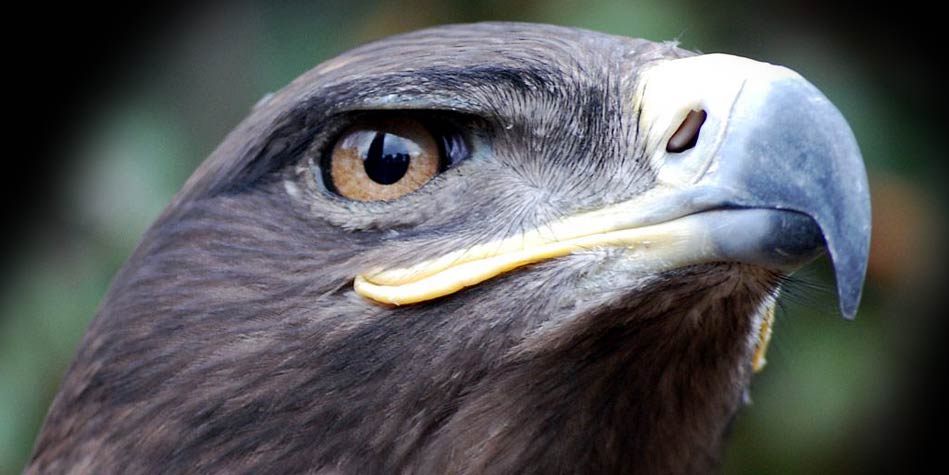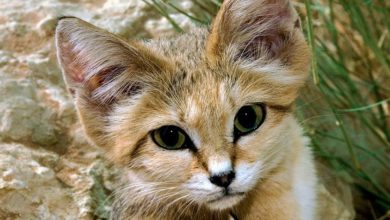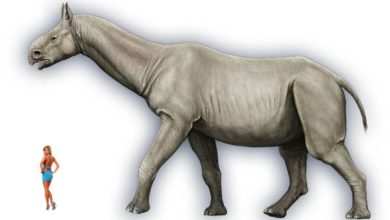Steppe eagle (Aquila nipalensis)
The eagle with the dietary habits of a vulture. Its menu is dominated by fresh carrion, it stays away from rotten flesh. More slender than a golden eagle (Aquila chrysaetos), but equally eminent. A thief and a slyboots – the steppe eagle is undoubtedly one of the most interesting birds in the whole Aquila genus.
Classification
- Class: Aves
- Order: Accipitriformes
- Family: Accipitridae
- Genus: Aquila
- Species: Aquila nipalensis

Subspecies and range
Eastern subspecies (Aquila nipalensis nipalensis)
It nests in the Altai mountains, East Mongolia, South Tibet all the way to East China. Most birds spend winters in the southern parts of Asia.
European and Central Asian subspecies (Aquila nipalensis orientalis)
South-East Europe, North Russia, Central Asia, Far East, central and eastern Kazakhstan are its breeding territories. During winter it migrates to the Middle East, Arabian Peninsula, the East and South Africa.
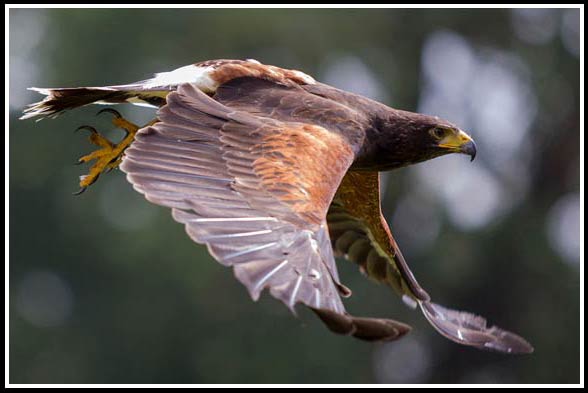
Former areas of occurrence and preferred habitats
The original distribution of this species included the regions from East Europe to Central Asia (from Tibet to Manchuria) and East Asia, especially Mongolia. Today in Europe it lives only in the northern parts of Russia and to the north-east of the Caspian Sea. It makes nests in Moldavia and Romania, formerly also present in the Ukrainian steppes, but long gone from these regions.
Most of the European and Western Asian steppe eagles spend winter in the East and South Africa, some migrate to the Arabian Peninsula, whereas birds from the Far East spend winters in India and neighboring states.
As the sole name suggests, the steppe eagle prefers open, dry areas, which means it mostly chooses deserts, savannas and grassland steppes. It lives at an altitude of up to 3000 meters (9,840 ft) above sea level, but it can also be observed even as high as 7900 meters (25,900 ft) above sea level.
An average territory has an area of about 30 – 50 km2 (11 – 19 mi²) though sometimes it can be as large as 100km2 (40 mi²) As the steppe eagle chooses scarcely wooded areas, it builds its nests on the ground, on rocky slopes, as well as in bushes and on telegraphic poles.
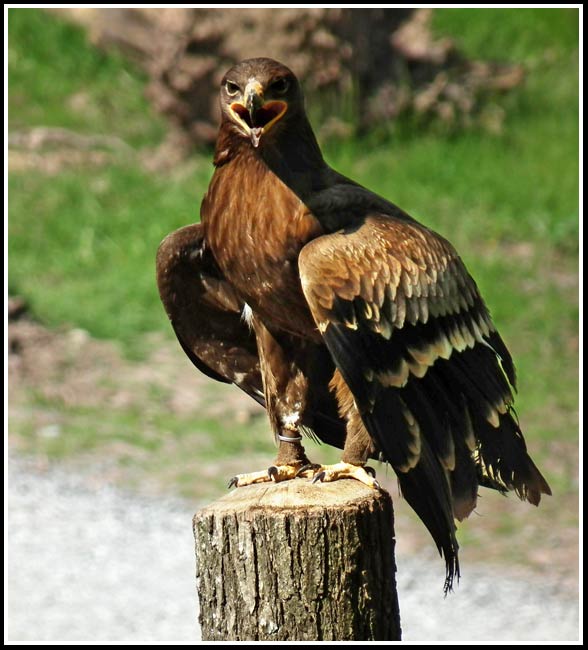
Characteristic
Appearance
The differences in the coloration and size between the subspecies are minor: A. n. nipalensis is slightly larger and darker than A. n. orientalis. Generally speaking, the bird reaches 62–81 cm (24–32 in) of length, having a wingspan of 165–215 cm (5.4–7.1 ft), weighing around 2.3–4.9 kg (5.1–10.8 lb). As for all eagles, females are larger and heavier than males.
Its feathering is dominated by bright and dark brown, often with a yellow or russet accent on the nape. Remiges and tail have the darkest color, almost black. Bottoms of wings show a single bright or even white stripe. Its eyes are brown, the beak is hooked, dark gray at the tip, yellow at the base. The tail is relatively short and wedge-shaped, legs are covered all over with fluffy brown feathers, the bare tarsus being yellow. Adolescent birds are distinctive for their white spot at the neck; they reach adult coloration around 3 – 4 years of age.
In terms of appearance, the steppe eagle is most similar to the tawny eagle (Aquila rapax), its cousin being brighter-colored and slightly smaller.
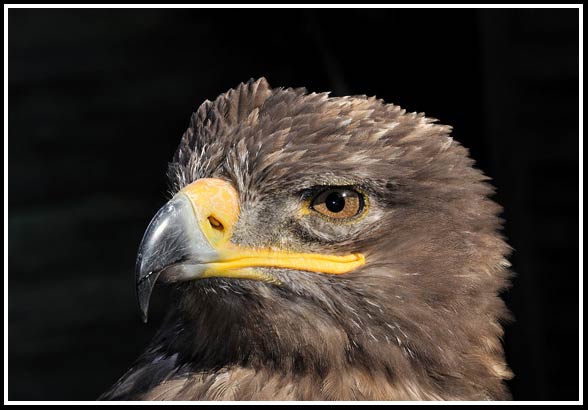
Diet and hunting style
It mostly hunts for small mammals, especially gophers, as well as small birds, reptiles and insects. Nevertheless, fresh carrion is its most valued delight, being also the foundation of its diet. It also does not hesitate to steal food.
It has a special crop in its gullet that can be used for storing food prior to its swallowing or heaving to feed the offspring.
It seeks prey flying over its territory. When a victim is spotted, it dives towards it and kills on the ground with its powerful talons. Alternatively, it can steal food from other birds mid-flight or catch a rodent trying to make shelter in its burrow. In case of the A. n. orientalis subspecies, rodents (especially gophers) are vital element of these eagles` diet – in the hatching season they account for even 98% of their menu. Carrion is most often eaten in the migratory regions – another ample source of food on foreign ground, especially in RSA, are termites.

Behavior and breeding
The steppe eagle is a nomadic species. Prior to the coldest months of the year, it migrates to the southern regions (India, Middle East). Hatching migrations usually begin in the middle of February, chicks appear about a month later.
It spends relatively much time on the ground when compared to other birds, it is also very calm and rarely vocalizes (beyond the breeding season).
It arrives at the hatching grounds around March or April. It builds a large nest about 1 m wide and 50 cm deep. Small twigs provide construction material; the interior is bedded with old cloths, straw, or camel excrements. The structure is built on the ground, yet due to hunting and protection issues resulting in the forced change of habitats, the bird gradually moves towards the tree formations, bushes and artificial human constructions. Both males and females actively take part in building the nest.
One clutch consists of 1 to 3 white eggs, covered with brown-yellow speckles, which are incubated approx. for the next 45 days. After about 60 days from the hatching chicks are feathered and may leave the home nest. The reproductive success in a given hatching season is inextricably woven with the size of the gopher population, being the main source of food for the nestlings.
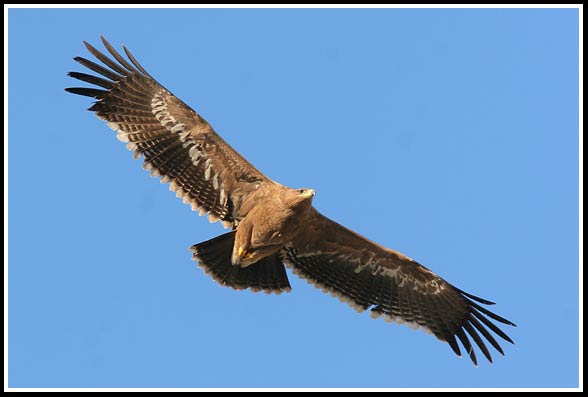
One of the fastest birds in the world
Steppe eagle is one of the world’s fastest birds. It may fly as fast as 60 km/h in a horizontal flight, reaching even 300 km/h in a diving flight.
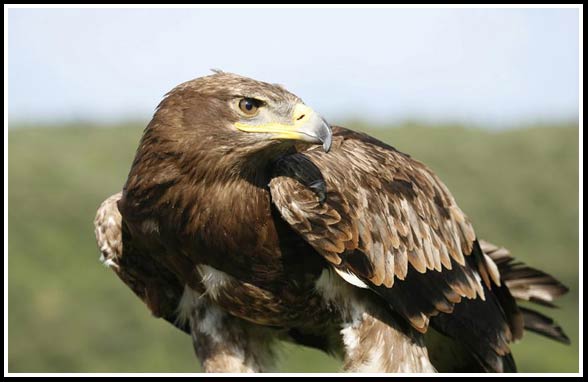
Detailed characteristics / size
Steppe eagle (Aquila nipalensis)
- Body length: 62–81 cm (24–32 in)
- Wingspan: 165–215 cm (5.4–7.1 ft)
- Weight:
- females: 2.3–4.9 kg (5.1–10.8 lb)
- males: 2–3.5 kg (4.4–7.7 lb)
- Lifespan: up to 30 years in the wild, even 40 years in captivity
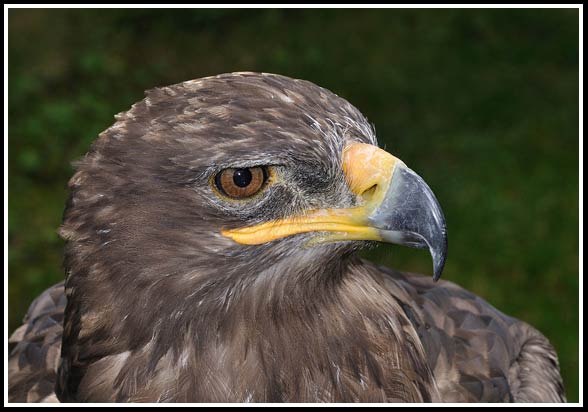
Steppe eagle – interesting facts
- Steppe eagle is a rather quiet bird. Its rare vocalizations resemble those of a raven, rook, or crow.
- It is a very cunning hunter – an eagle living in East Africa had been observing the underground route of a Spalax mole-rat, noticing the ground movements: afterward it flied to this very spot and tried to dig the prey out with its claws.
- The steppe eagle may make a nest on an abandoned car.
- A clutch of 5 eggs was recorded only twice.
- In the migration seasons, people of Asia observe numerous steppe eagles passing through the sky – inhabitants of the Khare village (Nepal) between October and November estimated that about 15 birds crossed the sky every hour.
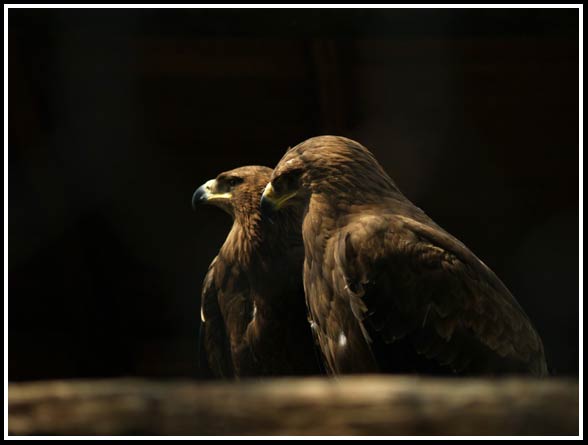
Recommended
- Eagles
- Animals records
- Largest eagles Top10
- Largest birds of prey Top10
- Haast’s eagle
- Bald eagle
- Black eagle
- Steller’s sea eagle
- Philippine eagle
- Crowned eagle
- Martial eagle
- Wedge-tailed eagle
- Eastern imperial eagle
- Bearded vulture
- Fastest animals – Top 10
- Fastest birds – Top 10
- Most venomous snakes – Top 10
- Largest sharks Top 10
- Heaviest land animals
- Largest crocodiles Top 10
- Largest whales TOP 10
- Longest snakes Top 10
- Highest (Top) flying bird – Top 10
- Largest and heaviest birds
- Largest turtles TOP 10

